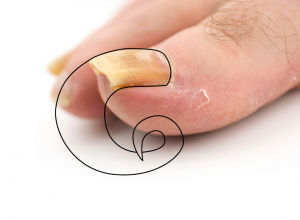
Ram’s Horn Nails
Ram’s horns nails, also called onychogryphosis, is a condition characterized by a thickening and lengthening of the fingernails or toenails to such a degree that they begin to resemble claws or a ram’s horn.
Symptoms
Onychogryphosis is characterized by an extreme thickening and lengthening of the nails (either toenails or fingernails). The affected nails begin to grow into claw-like or ram’s horn-like shapes that make them difficult to cut and trim. Nails affected by onychogryphosis eventually turn brown or yellowish in color and become so thick, they’re impossible to cut with nail clippers or scissors.
The condition is not to be confused with onychauxis, which is an annormal overgrowth or thickening of the nail without deformity that can sometimes happen with age or due to underlying health conditions like diabetes and psoriasis.
Causes
The most common cause of onychogryphosis is self-neglect coupled with a failure to cut the nails for an extended period of time. It is most often seen in the elderly community, as many older people don’t have the ability or wherewithal to practice good hygiene.
Other cases of onychogryphosis are caused by trauma to the hands and feet, peripheral vascular disease, fungal infections, ichthyosis and syphilis. Sometimes onychogryphosis is congenital, meaning it is present at birth and therefore hereditary.
Treatment
More often than not, onychogryphosis is treated with avulsion of the nail plate (complete nail removal). The procedure for removing a toenail begins with a podiatrist injecting a local anesthetic followed by forcefully pulling the toenail out of the nail bed. Though it seems torturous, the procedure is relatively painless.
Nail avulsion can lead to chronic ingrown toenails when done on the feet, so some doctors may also surgically destroy the nail matrix with phenol or a carbon dioxide laser to prevent ingrown nails. The procedure is known as a partial or full matrixectomy (permanent nail removal).
If left untreated, onychogryphosis can lead to nails growing into the skin, which causes pain, inflammation and infection. It also leaves the feet and hands a perfect place for different types of fungus to thrive.
Notice concerning medical entries:
Articles having medical content shall serve exclusively for the purpose of general information. Such articles are not suitable for any (self-) diagnosis and treatment of individual illnesses and medical indications. In particular, they cannot substitute for the examination, advice, or treatment by a licensed physician or pharmacist. No replies to any individual questions shall be effected through the articles.






